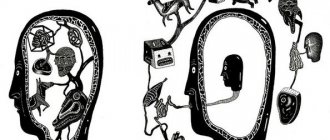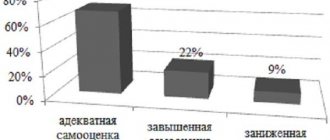Instructions: rate 25 proposed situations on a scale from 1 to 4 points, depending on how much they would upset you. The average passage time is up to 10 minutes. If you begin to notice frequent attacks of anger or irritation over trifles, which was not typical before, you need to check what caused the character changes. Hot reactions are the body’s defense against external material and intangible threats. In controlled doses they are the norm, but the uncontrolled form entails a number of social and medical problems. Take the test to determine the level of anger and irritability on the R. Novaco scale online. The questionnaire of the American doctor of psychology Raymond Novaco is available for free, and access to it does not require registration on the site.
A person’s irritability is activated by internal aggression. If this feeling predominates in the personality profile, frequent attacks of anger and rudeness are possible. Such people have conflicts; it is difficult for them to communicate with others because of their lack of restraint and straightforwardness.
Common causes of multidimensional anger are:
- Physiological disorders;
- Tense psychological atmosphere in the family, at work;
- Chronic stress and depression;
- Consequences of emotional trauma.
You can separate anger as an innate character trait from a consequence of human health problems by the accompanying symptoms: anxiety, excitability, loss of strength, sleep disturbances, exacerbations of diseases.
Signs of pathological aggressiveness cover a wide range of manifestations and can be the result of completely different abnormalities. The Novako technique is designed specifically to identify symptoms of high nervousness and irritability. Her points describe unpleasant situations that are close to many people. But the degree of displeasure can vary - from mild annoyance to uncontrollable rage. By choosing the appropriate answer option in the questionnaire, the respondent shows the level of dynamism or stability of his nervous system.
Response options are assessed on a 4-point scale. To display the result, the sum of the points scored is calculated. The maximum number is 100 points. The interpretation of the total is as follows:
- less than 45 points – commendable composure.
- 46–55 points – below the statistical average.
- 56–75 points – average excitability.
- 76–85 points – high degree of susceptibility to anger.
- 86–100 points – explosive anger. You boil over at the slightest provocation and don’t cool down for a long time. The condition may be accompanied by headaches, nervous and muscle tension, and tachycardia.
The ability to restrain anger is a condition obligatory for a social person. If you overreact to everything, the nervous system will fail before nature’s appointed time. Take the Novako Irritability Test online and for free to determine your limits of patience.
What are the causes of increased irritability in women and men?
Genetic, hereditary and medical factors that stimulate aggressiveness are the same for both sexes, and can manifest themselves in childhood. Physiology is of great importance - the production of hormones and the specificity of thinking. Women's monthly cycles and malfunctions of the reproductive system are a common cause of inadequate worldview among women.
Men are greatly influenced by self-realization in the main roles: breadwinner, conqueror, leader, guardian. Failures in any field can put a man into depression, manifested by excessive anger and bouts of aggression.
Aggression test (Questionnaire L.G. Pochebut) psychology test on the topic
Aggression test (Questionnaire by L.G. Pochebut)
Scales: verbal aggression, physical aggression, object aggression, emotional aggression, self-aggression.
Purpose of the test: Diagnosis of aggressive behavior.
Test Description
In ethnopsychological research, a special place is occupied by the problem of studying aggressive behavior. Determining the level of aggressiveness can help in preventing interethnic conflicts and stabilizing the social and economic situation in the country. Aggressive behavior is a specific form of human action, characterized by a demonstration of superiority in force or the use of force in relation to another or a group of persons to whom the subject seeks to cause harm.
It is advisable to consider aggressive behavior as the opposite of adaptive behavior.
Adaptive behavior involves a person’s interaction with other people, coordination of the interests, requirements and expectations of its participants. Psychologists B. Bass and R. Darkey developed a test that assesses the level of a person’s aggressive behavior.
Test instructions
“The proposed questionnaire reveals your usual style of behavior in stressful situations and features of adaptation in a social environment. You need to clearly ("yes" or "no") rate the 40 statements below."
Processing and interpretation of test results
Aggressive behavior is divided into 5 scales according to the form of manifestation.
Verbal aggression (VA) – a person verbally expresses his aggressive attitude towards another person, uses verbal insults.
Physical aggression (PA) – a person expresses his aggression towards another person using physical force.
Object-based aggression (OA) – a person takes out his aggression on the objects around him.
Emotional aggression (EA) - a person experiences emotional alienation when communicating with another person, accompanied by suspicion, hostility, hostility or ill will towards him.
Self-aggression (SA) – a person is not in peace and harmony with himself; he has no or weakened psychological defense mechanisms; he finds himself defenseless in an aggressive environment.
Test
- During an argument, I often raise my voice.
- If someone annoys me, I can tell him everything I think about him.
- If I need to resort to physical force to protect my rights, I will do so without hesitation.
- When I meet someone I don't like, I can allow myself to discreetly pinch or push him.
- When I'm in an argument with another person, I may slam my fist on the table to get attention or prove that I'm right.
- I constantly feel that others do not respect my rights.
- Remembering the past, sometimes I feel sad for myself.
- Although I don’t show it, sometimes I feel jealous.
- If I do not approve of the behavior of my acquaintances, then I directly tell them about it.
- When I am very angry, I use strong language and use foul language.
- If someone raises a hand to me, I will try to hit him first.
- I get so angry that I throw things.
- I often have the need to rearrange the furniture in my apartment or change it completely.
- When communicating with people, I often feel like a “powder keg” that is constantly ready to explode.
- Sometimes I have a desire to make an evil joke at the expense of another person.
- When I'm angry, I usually become gloomy.
- When talking to a person, I try to listen to him carefully without interrupting.
- In my youth, my fists often itched and I was always ready to use them.
- If I know that a person deliberately pushed me, then things can lead to a fight.
- Keeping my desk creatively cluttered allows me to work efficiently.
- I remember being so angry that I would grab anything I could get my hands on and break it.
- Sometimes people irritate me just by their presence.
- I often wonder what hidden reasons force another person to do something good for me.
- If I am offended, I will lose the desire to talk to anyone.
- Sometimes I deliberately say nasty things about a person I don't like.
- When I'm angry, I shout the most vicious curse words.
- As a child, I avoided fighting.
- I know why and when to hit someone.
- When I'm angry, I can slam the door.
- It seems to me that the people around me don't like me.
- I constantly share my feelings and experiences with others.
- Very often I harm myself with my words and actions.
- When people yell at me, I respond in kind.
- If someone hits me first, I will hit him back.
- It irritates me when things are out of place.
- If I cannot fix a broken or torn object, then in anger I break it or completely tear it.
- Other people always seem to be successful to me.
- When I think about a person who is very unpleasant to me, I can become excited with a desire to harm him.
- Sometimes I feel like fate has played a cruel joke on me.
- If someone doesn't treat me right, I get very upset about it.
Processing and interpretation of test results
Aggressive behavior is divided into 5 scales according to the form of manifestation.
Verbal aggression (VA) – a person verbally expresses his aggressive attitude towards another person, uses verbal insults.
Physical aggression (PA) – a person expresses his aggression towards another person using physical force.
Object-based aggression (OA) – a person takes out his aggression on the objects around him.
Emotional aggression (EA) - a person experiences emotional alienation when communicating with another person, accompanied by suspicion, hostility, hostility or ill will towards him.
Self-aggression (SA) – a person is not in peace and harmony with himself; he has no or weakened psychological defense mechanisms; he finds himself defenseless in an aggressive environment.
Key for processing the test:
| Type of aggression | approval number | |
| Yes | No | |
| VA | 1, 2, 9, 10, 25, 26, 33 | 17 |
| F | 3, 4, 11,1 8, 19, 28, 34 | 27 |
| PA | 5, 12, 13, 21, 29, 35, 36 | 20 |
| EA | 6, 14, 15, 22, 30, 37, 38 | 23 |
| SA | 7, 8, 16, 24, 32, 39, 40 | 31 |
Mathematical processing. First, the scores for each of the five scales are summed up.
If the score is above 5, this means a high degree of aggressiveness and a low degree of adaptability on the scale.
A score of 3 to 4 corresponds to an average degree of aggression and adaptability. A score from 0 to 2 means a low degree of aggressiveness and a high degree of adaptation for this type of behavior. The scores on all scales are then summed.
If the sum exceeds 25 points, this means a high degree of aggressiveness of a person and low adaptive capabilities.
The total score from 11 to 24 corresponds to the average level of aggressiveness and adaptability.
A score from 0 to 10 indicates a low degree of aggressiveness and a high degree of adapted behavior.
As a result of the research, the validity of the test was tested on 483 subjects. Intrascale correlation coefficients exceed 0.35 and are significant at the 5% level.
Platonov Yu.P. Fundamentals of ethnic psychology. Textbook allowance. – St. Petersburg: Rech, 2003, p. 383-385.
Protocol
Questionnaire L.G. Scrub
Full name_______________________________________________________________
Group______ Age_______ Date_____
You need to clearly (“yes” or “no”) evaluate 40 statements
| 1 | 11 | 21 | 31 | ||||
| 2 | 12 | 22 | 32 | ||||
| 3 | 13 | 23 | 33 | ||||
| 4 | 14 | 24 | 34 | ||||
| 5 | 15 | 25 | 35 | ||||
| 6 | 16 | 26 | 36 | ||||
| 7 | 17 | 27 | 37 | ||||
| 8 | 18 | 28 | 38 | ||||
| 9 | 19 | 29 | 39 | ||||
| 10 | 20 | 30 | 40 |
| Agricultural type | №? | ∑ | >5 high degree of aggression and low degree of adaptability on the scale 3-4 average degree 0-2 low degree and high degree of adaptability on the scale | |
| Yes | No | |||
| VA | 1, 2, 9, 10, 25, 26, 33 | 17 | ||
| F | 3, 4, 11,1 8, 19, 28, 34 | 27 | ||
| PA | 5, 12, 13, 21, 29, 35, 36 | 20 | ||
| EA | 6, 14, 15, 22, 30, 37, 38 | 23 | ||
| SA | 7, 8, 16, 24, 32, 39, 40 | 31 | ||
| Total | >25 means a high degree of aggression and low adaptive capabilities 11-24 average level of aggressiveness and adaptability 0-10 low degree of aggressiveness and high degree of adapted behavior. | |||
Result_________________________________________________________________________________________________________________________________________________________________________________________________________________________
_____________________________________________________________________________
Educational psychologist
How to recognize hidden aggression in a person?
A person with hidden aggression masks his actions. He is ready to strike unexpectedly, grins when talking, and shows offensive gestures.
A person who shows passive aggression is, in fact, also your personal psychological vampire. Let's say you interact with 20 people more often than usual - if 7 of them have a consistently negative impact on your mood = expect trouble.
Some specific examples of this behavior:
- Let's imagine a conflict situation. You are trying to prove something to a person, convincing him that he is right. And he persistently pretends that you are not there, openly ignores you;
- You asked your opponent a question, but did not give an answer. Then the person “breaks through” and a barrage of accusations and insults hits you. As a result, you become the one to blame;
- “This is all gossip and slander against me”: this can often be heard from the lips of a person - an aggressor;
- Observe a person how he behaves in a difficult situation. The hidden aggressor will most likely say: “Well, I knew it, it was to be expected, but I said...”;
- Such a person loves to play the “silent game”;
- Frequent touchiness, intolerance, the desire to label everyone, irony towards people: all these are manifestations of hidden aggression.
Where is this test used?
Diagnosis using the S. Deinhoff aggression questionnaire is recommended in psychological practice for patients with impaired self-control, signs of cruelty, increased hostility and some other disorders. The model is used in forensic medicine, correctional institutions, and educational centers.
The questionnaire is of interest to people who have difficulty managing anger, excitable, unbalanced individuals. Its results may be the basis for contacting a psychotherapist and prescribing a course of medication after a clinical examination.
How do negative emotions affect your health?
You can and should be angry, but without fanaticism
Do you still think that anger just spoils the mood? No! It negatively affects the entire body!
- Constricts blood vessels, causing them to wear out faster.
- Increases heart rate, pulse, breathing. Leads to groundless anxiety.
- Increases the risk of heart attack by almost 9 times!
- Increases the risk of arthritis, diabetes and cancer.
- May lead to nausea and eating disorders.
- Triggers early aging processes.
- Weakens your immune system and makes you more susceptible to all sorts of “illnesses”.
- Can cause bronchial asthma and other bronchial diseases.
- It becomes an impetus for bad habits, such as smoking, alcohol addiction, overeating, and a passive lifestyle.
- Leads to hair loss, brittle nails, brittle teeth and bones.
Take the test and find out if you are a conflict person?
This video test will help you determine how angry you are. Bring yourself a piece of paper and a pen!
Interpretation of results
According to Rogov E.I., the norm for aggressiveness is its index value equal to 21 ± 4, and for hostility – 6.5-7 ± 3. At the same time, attention is drawn to the possibility of achieving a certain value indicating the degree of manifestation of aggressiveness.
Khvan A.A. co-author proposes a more complex scheme. The raw scores for each scale must be multiplied by a factor, the purpose of which is to bring the maximum value for each scale to 100 points. These points are then converted into walls:
| Walls | Results in points | Interpretation | |
| Physical aggression | Indirect aggression | ||
| Verbal aggression | Irritation | ||
| Negativism | Suspicion | ||
| Guilt | Resentment | ||
| 1 | 0 — 20 | 0 | low level |
| 2 | 20 — 30 | 0 — 14 | |
| 3 | 31 — 41 | 15 – 25 | average level |
| 4 | 42 -52 | 26 – 36 | |
| 5 | 53- 63 | 37 – 47 | increased level |
| 6 | 64 -74 | 48 – 58 | |
| 7 | 75 — 85 | 59 – 69 | |
As mentioned above, physical, indirect and verbal aggression together form a total index of aggressive reactions, and resentment and suspicion form an index of hostility.
| Walls | Results in points | Interpretation | |
| Aggressiveness | Hostility | ||
| 1 | 0 – 17 | 0 | low level |
| 2 | 18 – 27 | 0 – 14 | |
| 3 | 28 – 38 | 15 – 25 | average level |
| 4 | 39 – 49 | 26 – 36 | |
| 5 | 50 — 60 | 37 – 47 | increased level |
| 6 | 61 — 71 | 48 – 58 | |
| 7 | 72 — 82 | 59 – 69 | high |
| 8 | 83 — 93 | 70 – 80 | very tall |
| 9 | 94 or more | 81 – 92 | |
| 10 | 92 or more | ||
Using this technique, it is necessary to remember that aggressiveness, as a personality trait, and aggression, as an act of behavior, can be understood in the context of a psychological analysis of the motivational-need sphere of the individual. Therefore, the Bass-Darkey questionnaire should be used in conjunction with other methods: personality tests of mental states (Cettell, Spielberger), projective methods (Lüscher) and so on.








